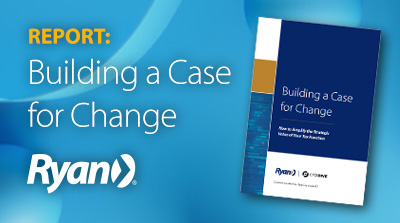Ryan European Survey Confirms Significant Disconnect Between Tax and Finance Functions
Why today’s tax functions need to amplify their strategic value within the business
Ryan, in conjunction with Industry Dive, a leading business journalism company, recently polled finance and tax executives across 13 countries in Europe. The objective of the research was to understand the current state of the tax function and to identify the challenges and potential risks that today’s tax departments face. The results revealed a significant disconnect between the perceptions of finance executives and tax executives on various tax topics, while highlighting function-driven dissonance. The results also provide the foundation for a business case for change, to amplify the strategic value of the tax function within the wider organisation. “Without a clear vision and commitment of resources, tax professionals will be stuck in a low-level, repetitive loop. Tax executives have two choices: persist in the status quo or build a compelling business case for change,” Andrew Burman, Tax Transformation Principal, Ryan. Tax professionals are seemingly far more concerned than finance over tax complexity.While both tax and finance executives recognised the evolving complexity of the tax environment, more tax executives are concerned that outmoded technology will pose a significant challenge compared to their finance counterparts. The survey showed that 68% of tax executives felt that outmoded technology causing errors will impact the effectiveness of their tax function in the next three years, compared to 37% of finance executives holding this view. Furthermore, even though tax and finance also agree that the need for real-time compliance requirements will require process and technology changes, the scope of these changes is often difficult to predict. What’s more, roughly half of the tax professionals in this survey simply didn’t know where to start tackling the known gaps. Lack of strategic clarity could leave the tax department stranded in a repetitive low-level loop.Forty three percent of tax practitioners feel that their company lacked a clear strategic vision when it comes to transforming the tax function, compared to 77% of senior finance executives. The danger of this disconnect is that companies will place a low priority on investing in necessary tax automation technology, resulting in increased audit risk and costs, and ultimately, keep the tax department stranded in “a repetitive compliance loop.” “As long as finance doesn’t see the potential for tax to contribute to the bottom line and bring cash back into the organisation by reducing taxes paid, the tax function will be stuck in the low value-added loop, reacting to change, with outmoded technology,” says Andrew Burman, Tax Transformation Principal at Ryan. The implications can be far-reaching, he adds, and range from limiting the potential of tax to positively impacting the business, to increased audit risk and related compliance costs. Competing priorities impede investment in tax transformation.Most tax professionals recognised the importance of transforming their tax function to meet the complexities of an evolving tax landscape. However, the road forward has not always been clear and is often hampered by a lack of commitment to divert resources to tax transformation investments. Competing priorities often prevail and inhibit the true potential of the tax function to deliver long-term strategic value to the company. Over 70% of tax professionals feel they are being overlooked when it comes to investing in transformative technology. Almost 80% felt that the lack of investment was because the tax department wasn’t seen as a source of strategic value. However, relatively fewer finance executives held this view, with only 58% indicating that competing priorities were diverting technology investment away from the finance function. Tangible solutions to close the perception gap.With a goal to ensure that the tax department can meet the challenges of increasing tax complexity while optimising costs and providing strategic value to their companies, a critical question is how to foster alignment between the tax and finance departments. According to Ben Knock, Managing Director and VP of VAT Compliance, Consulting and Reclaim at Ryan, it’s first about helping CFOs and tax professionals to understand the changing tax landscape in Europe, and why companies need to be prepared. “Often the people on the tax team are having to be reactive to these changes, so helping the C-suite understand what’s coming up, what the implications are, and what they can do to make sure their systems are ready for the changes is really important,” he says. Tax professionals need to demonstrate that an investment in tax technology has multiple benefits, including reduced audit risk, a more efficient use of department employees’ time, and a sustained return on investment. To that end, having an intermediary that can work between tax, finance and IT, who speaks the language of each, can be of significant value, adds Jun Miyake, Principal, Tax Technology. “It’s not expected that these groups speak the same language, and that’s why engaging an expert partner who has deep experience in all three cannot only explain why tax transformation is necessary but can expedite the tax transformation process and help find the budget to do it.” The results of the survey demonstrate the importance of the evolution of the tax function and why tax professionals urgently need to bridge the perception gap between finance and tax and raise the profile of the tax function within the C-suite. Read the full report now to take a deeper dive into the insights that were uncovered and see how the tax function can fight the deprioritisation of tax. By turning the challenge into an opportunity, today’s tax functions, with the help of intermediary partners, can elevate their true value within the organisation, transforming from a reactive cost centre into a strategic profit centre, thereby unleashing the tax function’s strategic potential. |
